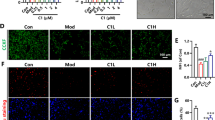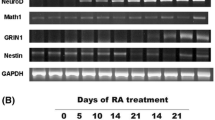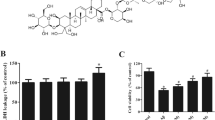Abstract
Alzheimer’s disease (AD) is a prevalently neurodegenerative disease characterized by neuronal damage which is associated with amyloid-β (Aβ) accumulation. Hederagenin is a triterpenoid saponin, exerting anti-apoptotic, anti-oxidative, anti-inflammatory, anti-tumoral, and neuroprotective activities. However, its role in AD progression is still obscure. The aim of this study was to explore the influences of hederagenin on Aβ-caused neuronal injury in vitro. Neuronal cells were treated with Aβ25–35 (Aβ) to establish a cellular model of AD. Cell viability was assessed using cell counting kit-8 (CCK-8). Oxidative stress was evaluated by detecting reactive oxygen species (ROS) generation and superoxide dismutase (SOD) activity. Apoptosis was investigated using TUNEL staining and caspase-3 activity assays. Protein tyrosine phosphatase nonreceptor type 1 (PTPN1) was screened by bioinformatics analysis. Protein levels of PTPN1 and protein kinase B (Akt) were measured by western blotting. Hederagenin (2.5, 5, and 10 μM) alone did not affect viability of neuronal cells, but relieved Aβ-induced viability reduction. Hederagenin mitigated Aβ-induced increase in ROS accumulation and decrease in SOD activity. Hederagenin attenuated Aβ-induced increase in apoptotic rate and caspase-3 activity. PTPN1 was screened as a target of hederagenin against AD by bioinformatics analysis. Hederagenin treatment resisted Aβ-induced decrease in PTPN1 mRNA and protein levels in neuronal cells. PTPN1 silencing attenuated the suppressive functions of hederagenin in Aβ-stimulated oxidative stress and apoptosis. Hederagenin mitigated Aβ-induced Akt signaling inactivation by upregulating PTPN1 expression. In conclusion, hederagenin attenuates oxidative stress and apoptosis in neuronal cells stimulated with Aβ by promoting PTPN1/Akt signaling activation.











Similar content being viewed by others
Data Availability
The data that support the findings of this study are available from the corresponding author upon reasonable request.
References
Abdelsalam SS, Korashy HM, Zeidan A, Agouni A (2019) The role of protein tyrosine phosphatase (PTP)-1B in cardiovascular disease and its interplay with insulin resistance. Biomolecules 9(7):286
Athar T, Al Balushi K, Khan SA (2021) Recent advances on drug development and emerging therapeutic agents for Alzheimer’s disease. Mol Biol Rep 48(7):5629–5645
Bai R, Guo J, Ye XY, Xie Y, Xie T (2022) Oxidative stress: The core pathogenesis and mechanism of Alzheimer’s disease. Ageing Res Rev 77:101619
Brenowitz WD, Xiang Y, McEvoy CT, Yang C, Yaffe K, Le WD et al (2021) Current Alzheimer disease research highlights: evidence for novel risk factors. Chin Med J (Engl) 134(18):2150–2159
Ceylan H (2022) Integrated bioinformatics analysis to identify alternative therapeutic targets for Alzheimer’s disease: insights from a synaptic machinery perspective. J Mol Neurosci 72(2):273–286
Chen N, Wang J, He Y, Xu Y, Zhang Y, Gong Q et al (2020) Trilobatin protects against abeta25-35-induced hippocampal HT22 cells apoptosis through mediating ROS/p38/caspase 3-dependent pathway. Front Pharmacol 11:584
Chen X, Drew J, Berney W, Lei W (2021) Neuroprotective natural products for Alzheimer’s disease. Cells 10(6):1309
Daina A, Michielin O, Zoete V (2019) SwissTargetPrediction: updated data and new features for efficient prediction of protein targets of small molecules. Nucleic Acids Res 47(W1):W357–W364
Ding Y, Zhang H, Liu Z, Li Q, Guo Y, Chen Y et al (2021) Carnitine palmitoyltransferase 1 (CPT1) alleviates oxidative stress and apoptosis of hippocampal neuron in response to beta-Amyloid peptide fragment Abeta25-35. Bioengineered 12(1):5440–5449
Forman HJ, Zhang H (2021) Targeting oxidative stress in disease: promise and limitations of antioxidant therapy. Nat Rev Drug Discov 20(9):689–709
Ghasemi R, Zarifkar A, Rastegar K, Maghsoudi N, Moosavi M (2014) Insulin protects against Abeta-induced spatial memory impairment, hippocampal apoptosis and MAPKs signaling disruption. Neuropharmacology 85:113–120
Hou TY, Zhou Y, Zhu LS, Wang X, Pang P, Wang DQ et al (2020) Correcting abnormalities in miR-124/PTPN1 signaling rescues tau pathology in Alzheimer’s disease. J Neurochem 154(4):441–457
Jin T, Li D, Yang T, Liu F, Kong J, Zhou Y (2019) PTPN1 promotes the progression of glioma by activating the MAPK/ERK and PI3K/AKT pathways and is associated with poor patient survival. Oncol Rep 42(2):717–725
Karran E, De Strooper B (2022) The amyloid hypothesis in Alzheimer disease: new insights from new therapeutics. Nat Rev Drug Discov 21(4):306–318
Khan A, Ali A, Junaid M, Liu C, Kaushik AC, Cho WCS, Wei DQ (2018) Identification of novel drug targets for diamond-blackfan anemia based on RPS19 gene mutation using protein-protein interaction network. BMC Syst Biol 12(Suppl 4):39
Kim GJ, Song DH, Yoo HS, Chung KH, Lee KJ, An JH (2017) Hederagenin supplementation alleviates the pro-inflammatory and apoptotic response to alcohol in rats. Nutrients 9(1):41
Knopman DS, Amieva H, Petersen RC, Chetelat G, Holtzman DM, Hyman BT et al (2021) Alzheimer disease. Nat Rev Dis Primers 7(1):33
Kostrzewa T, Styszko J, Gorska-Ponikowska M, Sledzinski T, Kuban-Jankowska A (2019) Inhibitors of protein tyrosine phosphatase PTP1B with anticancer potential. Anticancer Res 39(7):3379–3384
Liang B, Li C, Zhao J (2016) Identification of key pathways and genes in colorectal cancer using bioinformatics analysis. Med Oncol 33(10):111
Liang BF, Huang F, Wang HT, Wang GH, Yuan X, Zhang MZ et al (2015) Involvement of norepinephrine and serotonin system in antidepressant-like effects of hederagenin in the rat model of unpredictable chronic mild stress-induced depression. Pharm Biol 53(3):368–377
Liang W, Xie Z, Liao D, Li Y, Li Z, Zhao Y et al (2023) Inhibiting microRNA-142-5p improves learning and memory in Alzheimer’s disease rats via targeted regulation of the PTPN1-mediated Akt pathway. Brain Res Bull 192:107–114
Lin P, Sun J, Cheng Q, Yang Y, Cordato D, Gao J (2021a) The development of pharmacological therapies for Alzheimer’s disease. Neurol Ther 10(2):609–626
Lin R, Liu L, Silva M, Fang J, Zhou Z, Wang H et al (2021b) Hederagenin protects PC12 cells against corticosterone-induced injury by the activation of the PI3K/AKT pathway. Front Pharmacol 12:712876
Liu N, Zhang T, Sun J, Yao J, Ma L, Fu J et al (2021) An overview of systematic reviews of Chinese herbal medicine for Alzheimer’s disease. Front Pharmacol 12:761661
Long HZ, Cheng Y, Zhou ZW, Luo HY, Wen DD, Gao LC (2021) PI3K/AKt signal pathway: A target of natural products in the prevention and treatment of Alzheimer’s disease and Parkinson’s disease. Front Pharmacol 12:648636
Mahaman YAR, Embaye KS, Huang F, Li L, Zhu F, Wang JZ et al (2022) Biomarkers used in Alzheimer’s disease diagnosis, treatment, and prevention. Ageing Res Rev 74:101544
Nandi S, Saxena M (2020) Potential inhibitors of protein tyrosine phosphatase (PTP1B) enzyme: Promising target for type-II diabetes mellitus. Curr Top Med Chem 20(29):2692–2707
Pinero J, Ramirez-Anguita JM, Sauch-Pitarch J, Ronzano F, Centeno E, Sanz F et al (2020) The DisGeNET knowledge platform for disease genomics: 2019 update. Nucleic Acids Res 48(D1):D845–D855
Rao YL, Ganaraja B, Murlimanju BV, Joy T, Krishnamurthy A, Agrawal A (2022) Hippocampus and its involvement in Alzheimer’s disease: A review. 3 Biotech 12(2):55
Razani E, Pourbagheri-Sigaroodi A, Safaroghli-Azar A, Zoghi A, Shanaki-Bavarsad M, Bashash D (2021) The PI3K/Akt signaling axis in Alzheimer’s disease: a valuable target to stimulate or suppress? Cell Stress Chaperones 26(6):871–887
Ren X, Zhang J, Zhao Y, Sun L (2022) Senegenin inhibits abeta1-42-induced PC12 cells apoptosis and oxidative stress via activation of the PI3K/Akt signaling pathway. Neuropsychiatr Dis Treat 18:513–524
Safran M, Rosen N, Twik M, BarShir R, Stein TI, Dahary D et al (2021) The genecards suite. In: Abugessaisa I, Kasukawa T (eds) Practical Guide to Life Science Databases. Springer Nature Singapore, Singapore, pp 27–56. https://doi.org/10.1007/978-981-16-5812-9_2
Scheltens P, De Strooper B, Kivipelto M, Holstege H, Chetelat G, Teunissen CE et al (2021) Alzheimer’s disease. Lancet 397(10284):1577–1590
Schramm C, Wallon D, Nicolas G, Charbonnier C (2022) What contribution can genetics make to predict the risk of Alzheimer’s disease? Rev Neurol (paris) 178(5):414–421
Sharma B, Xie L, Yang F, Wang W, Zhou Q, Xiang M et al (2020) Recent advance on PTP1B inhibitors and their biomedical applications. Eur J Med Chem 199:112376
Sharma VK, Singh TG, Singh S, Garg N, Dhiman S (2021) Apoptotic pathways and Alzheimer’s disease: Probing therapeutic potential. Neurochem Res 46(12):3103–3122
Sun Y, Zhu R, Ye H, Tang K, Zhao J, Chen Y, Liu Q, Cao Z (2013) Towards a bioinformatics analysis of anti-Alzheimer’s herbal medicines from a target network perspective. Brief Bioinform 14(3):327–343
Tian K, Su Y, Ding J, Wang D, Zhan Y, Li Y et al (2020) Hederagenin protects mice against ovariectomy-induced bone loss by inhibiting RANKL-induced osteoclastogenesis and bone resorption. Life Sci 244:117336
Wang S, Xing N, Meng X, Xiang L, Zhang Y (2022) Comprehensive bioinformatics analysis to identify a novel cuproptosis-related prognostic signature and its ceRNA regulatory axis and candidate traditional Chinese medicine active ingredients in lung adenocarcinoma. Front Pharmacol 13:971867
Wang X, Liu D, Huang HZ, Wang ZH, Hou TY, Yang X et al (2018) A Novel microRNA-124/PTPN1 signal pathway mediates synaptic and memory deficits in Alzheimer’s disease. Biol Psychiatry 83(5):395–405
Wu AG, Zeng W, Wong VK, Zhu YZ, Lo AC, Liu L et al (2017) Hederagenin and alpha-hederin promote degradation of proteins in neurodegenerative diseases and improve motor deficits in MPTP-mice. Pharmacol Res 115:25–44
Xiong Y, Ruan YT, Zhao J, Yang YW, Chen LP, Mai YR et al (2022) Magnesium-L-threonate exhibited a neuroprotective effect against oxidative stress damage in HT22 cells and Alzheimer’s disease mouse model. World J Psychiatry 12(3):410–424
Yu H, Song L, Cao X, Li W, Zhao Y, Chen J et al (2020) Hederagenin attenuates cerebral ischaemia/reperfusion injury by regulating MLK3 signalling. Front Pharmacol 11:1173
Yu W, Yu W, Yang Y, Lü Y (2021) Exploring the key genes and identification of potential diagnosis biomarkers in Alzheimer’s disease using bioinformatics analysis. Front Aging Neurosci 13:602781
Zeng J, Huang T, Xue M, Chen J, Feng L, Du R et al (2018) Current knowledge and development of hederagenin as a promising medicinal agent: a comprehensive review. RSC Adv 8(43):24188–24202
Zhang W, Lv M, Shi Y, Mu Y, Yao Z, Yang Z (2021) Network pharmacology-based study of the underlying mechanisms of Huangqi Sijunzi decoction for Alzheimer’s disease. Evid Based Complement Alternat Med 2021:6480381
Zhao Y, Tan W, Sheng W, Li X (2015) Identification of biomarkers associated with Alzheimer’s disease by bioinformatics analysis. Am J Alzheimers Dis Other Demen 31(2):163–168
Author information
Authors and Affiliations
Contributions
Ke Li, Yu Wang, and Hongzao Ni contributed to designing and performing experiments, collecting and analyzing the data, and writing the manuscript. All authors reviewed the manuscript.
Corresponding author
Ethics declarations
Ethical Approval and Consent to Participate
Not applicable.
Consent for Publication
Not applicable.
Competing Interests
The authors declare no competing interests.
Additional information
Publisher's Note
Springer Nature remains neutral with regard to jurisdictional claims in published maps and institutional affiliations.
Rights and permissions
Springer Nature or its licensor (e.g. a society or other partner) holds exclusive rights to this article under a publishing agreement with the author(s) or other rightsholder(s); author self-archiving of the accepted manuscript version of this article is solely governed by the terms of such publishing agreement and applicable law.
About this article
Cite this article
Li, K., Wang, Y. & Ni, H. Hederagenin Upregulates PTPN1 Expression in Aβ-Stimulated Neuronal Cells, Exerting Anti-Oxidative Stress and Anti-Apoptotic Activities. J Mol Neurosci 73, 932–945 (2023). https://doi.org/10.1007/s12031-023-02160-9
Received:
Accepted:
Published:
Issue Date:
DOI: https://doi.org/10.1007/s12031-023-02160-9




